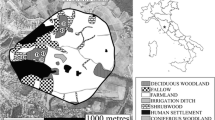Summary
We established depletable, artificial food patches in three habitats used by Indian crested porcupines (Hystrix indica) in a desert biome, and measured the number of food items remaining (i.e., “giving up density”=GUD) following nightly foraging bouts. Porcupines discriminated between resource types (peanuts vs. garbanzo beans), and exhibited clear habitat preferences in the face of uniform resource availability in time and space. Lowest GUD's (=lowest foraging costs) were in the habitat of densest cover, and during dark (little or no moon) nights. The results indicated a high sensitivity to predation risk. Crested porcupines behaved as expected of optimal foragers, and appear to be excellent subjects for further field experiments using the GUD approach.
Similar content being viewed by others
References
Alkon PU, Olsvig-Whittaker L (1989) Crested porcupine digs in Negev habitats: patterns of density, size, and longevity. J Arid Environ 17: 255–266
Alkon PU, Saltz D (1985) Potatoes and the nutritional ecology of crested porcupines (Hystrix indica) in a desert biome. J Appl Ecol 22: 727–737
Alkon PU, Saltz D (1988) Influence of season and moonlight on temporal-activity patterns of Indian crested porcupines (Hystrix indica). J Mammal 69: 71–80
Alkon PU, Degen AA, Cohen A, Pollack H (1986) Seasonal energy requirements and water intakes of Indian crested porcupines (Hystrix indica) in captivity. J Mammal 67: 333–342
Blair WF (1943) Activities of the Chihuahua deer-mouse in relation to light intensity. J Wild Mgmt 7: 92–97
Brown JS (1988) Patch use as an indicator of habitat preference, predation risk and competition. Behav Ecol Sociobiol 23: 27–43
Brown JS (1989) Desert rodent community structure: A test of four mechanisms of coexistence. Ecol Monogr 59: 1–20
Brown JS, Mitchell WA (1989) Diet selection on depletable resources. Oikos 54: 33–43
Brown JS, Kotler BP, Smith RJ, Wirtz WO II (1988) The effects of owl predation on the foraging behavior of heteromyid rodents. Oecologia 76: 408–415
Brownlee KA (1965) Statistical Theory and Methodology in Science and Engineering, 2nd Edition. Wiley, New York
Butynski TM (1984) Nocturnal ecology of the spring hare, Pedetes capensis, in Botswana. Afr J Ecol 22: 7–22
Caraco T (1979) Time budgeting and group size: a theory. Ecology 60: 611–617
Hay ME, Renaud PE, Fenical W (1988) Large mobile versus small sedentary herbivores and their resistance to seaweed chemical defenses. Oecologia 75: 246–252
Hodges CM, Wolf LL (1981) Optimal foraging in bumblebees: Why is nectar left behind in flowers? Behav Ecol Sociobiol 9: 41–44
Kotler BP (1984a) Risk of predation and the structure of desert rodent communities. Ecology 65: 689–701
Kotler BP (1984b) Harvesting rates and predatory risk in desert rodents: a comparison of two communities on different continents. J Mammal 65: 91–96
Kotler BP, Brown JS, Smith RJ, Wirtz WO II (1988) The effects of morphology and body size on rates of owl predation on desert rodents. Oikos 53: 145–152
Lima SL, Valone TJ, Caraco T (1985) Foraging efficiency-predation risk tradeoff in the gray squirrel. Anim Behav 33: 155–165
Lockard RB, Owings DH (1974a) Moon-related surface activity of bannertali (Dipodomys spectabilis) and Fresno (D. nitratoides) kangaroo rats. Anim Behav 22: 262–273
Lockard RB, Owings DH (1974b) Seasonal variation in moonlight avoidance by bannertail kangaroo rats. J Mammal 55: 189–193
Pimm SL, Rosenzweig ML, Mitchell W (1985) Competition and food selection: field tests of a theory. Ecology 66: 798–807
Price MV, Waser NW, Bass TA (1984) Effects of moonlight on microhabitat use by desert rodents. J Mammal 65: 353–356
Saltz D, Alkon PU (1989) On the spatial behaviour of Indian crested porcupines. J Zool Lond 217: 255–266
Sokal RR, Rohlf FJ (1981) Biometry, 2nd Edition. WH Freeman, New York
Steinberg PD (1988) Effects of quantitative and qualitative variation in phenolic compounds on feeding in three species of marine invertebrate herbivores. J Exp Mar Biol Ecol 120: 221–237
Valone TJ, Brown JS (1989) Measuring patch assessment abilities of desert granivores. Ecology 70: 1800–1810
Werner EE, Gilliam JF, Hall DJ, Mittlebach GG (1983) An experimental test of the effects of predation risk on habitat use in fish. Ecology 64: 1540–1548
Wilson DS (1976) Deducing the energy available in the environment: an application of optimal foraging theory. Biotropica 8: 96–103
Author information
Authors and Affiliations
Rights and permissions
About this article
Cite this article
Brown, J.S., Alkon, P.U. Testing values of crested porcupine habitats by experimental food patches. Oecologia 83, 512–518 (1990). https://doi.org/10.1007/BF00317202
Received:
Accepted:
Issue Date:
DOI: https://doi.org/10.1007/BF00317202




